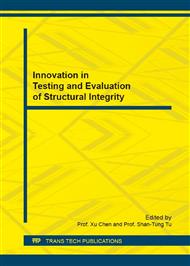p.15
p.22
p.28
p.33
p.41
p.46
p.51
p.57
p.62
A Prediction Model for Mode-III Fatigue Crack Growth
Abstract:
In the fracture mechanics, the failure of mode-III crack belongs to the anti-plane shear (also called out-plane shear or longitudinal shear). Fatigue crack growth (FCG) behavior under mode-III reversed load (load ratio R=-1) was studied by using 30Cr2Ni4MoV rotor steel with types of circumferential notches. Under the remote cyclic torsional load, the precrack process was applied to specimens with notch in the round bar, and the ideal sharp-crack was obtained. Then, mode-III FCG test under the remote cyclic torsional load and the axial constant small load was carried out until to fatigue failure. The axial constant small load is aimed at reducing the cracks interaction in the mode-III FCG experiment. Due to experimental data of 30Cr2Ni4MoV rotor steel, the mode-III FCG rate in the range of KIII from 12MPa·m1/2 to 40 MPa·m1/2 and the threshold value were got. Furthermore, a prediction model for mode-III FCG is proposed with considering the small scale yield of plane stress crack tip zone and the plastic strain energy density failure criteria. The predicted mode-III FCG rate is found to agree well with the experimental curves of 30Cr2Ni4MoV rotor steel.
Info:
Periodical:
Pages:
41-45
Citation:
Online since:
September 2016
Authors:
Price:
Сopyright:
© 2017 Trans Tech Publications Ltd. All Rights Reserved
Share:
Citation:


